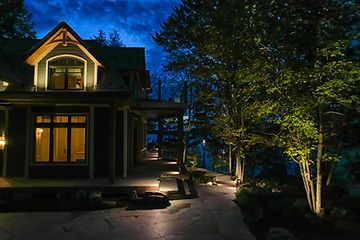Outdoor lighting improves the appearance, safety, and aesthetics of cottages; it may help you create a walkway to your lake-side deck, brighten your garden or form an intimate outdoor space.
It’s tempting to get carried away and acquire an abundance of products or use several different effects in the hopes that your landscape lighting would look sensational next to your cottage’s architecture. Instead, concentrate on core landscape lighting approaches that each serve a specific function.
So, what are the landscape lighting effects or techniques that professionals use?

Moonlight is sometimes superior to direct light. You may get this appearance with outdoor lighting by placing your soft lights very high up. The illumination will beam down on your space, casting magnificent shadows.
A type of illumination similar to moonlighting; the light source is installed high above the
property and shines light downwards. Downlighting is brighter than moonlighting and aims to illuminate larger regions. It’s an excellent choice for stairs, a driveway, or security purposes.


Also known as spotlighting, this approach uses an intense beam of light to emphasize specific aspects of your environment, such as sculptures, bushes, gardens, or flowers.
Diffused lighting utilizes low-level illumination that affects a greater area.
It’s great for paths, patios, flowers, or garden beds. LED lighting is especially effective at achieving this look.


With step lights, the illumination focuses on individual steps of the stairway (grand or minuscule).
Typically they’re installed in-ground, on the edge, or side of a surface.
Grazing accentuates a textured surface like a stone wall, tree trunk or tropical plant.
It’s achieved by positioning a light fixture within one foot of the surface and aiming the illumination so it’s parallel to the surface.


This is an excellent strategy for forested areas.
Cross lighting gives things, such as trees or sculptures, a 3D form by illuminating two or more sides of the item.
Draw attention to stone or significant architectural features by installing well lights near the foot of the feature, so the illumination can flow across the texture and leave diverse shadow effects.
It’s an excellent effect for an outdoor stone fireplace, brightening gloomy garages, driveways, and front doorways.


A spotlight illusion is created by placing light fixtures low and pointing them upwards.
Uplighting draws attention to essential things around the cottage, like garden beds, trees, or art pieces. Often, the light fixtures are in-ground.
Wall washing is an outdoor lighting effect that refers to the general illumination of a wall
or surface instead of highlighting a specific region or characteristic.


This technique creates or enhances shadows by adding lights behind large objects like trees, sculptures, etc., and pointing them to a surface.
The shadow will be a decorative element on the surface or wall.
Also known as backlighting, this effect is fascinating and dynamic but slightly difficult to describe. It involves illuminating an object behind the item yo
u’re silhouetting (usually a wall), which results in a black outline of the object you’re silhouetting against the light cast behind it.


At night, fixtures immersed in water features offer an extra distinctive impact.
The light will dance through the water and even cast shadows nearby. Ponds, fountains, and swimming pools can all use subversive lighting.
The most common type of landscape lighting is pathway lights. Frequently they use LED or solar lighting, and the fixtures are small posts with a capped light.
Warm white is the most popular colour choice for outdoor lights. Many people find the illumination bright, but not too harsh – so it maintains a welcoming feeling.
LED bulbs are the top choice for low-voltage landscape lighting. They outshine other bulbs while using less energy.
Landscape lighting is an art form that you can employ to make your landscape genuinely unique; these approaches might help whether you’re seeking to enhance the safety of the space or just make a place the main point of the yard.
An experienced outdoor lighting designer can select the best mix of these features to make the most of your cottage’s landscape. The team at Nightscapes of Muskoka is award-winning, and we service all types of cottages in the Muskoka region.
We highly recommend using LED bulbs for lighting systems; if you’re not familiar with them, check out the top 10 reasons why outdoor lighting should be LED.